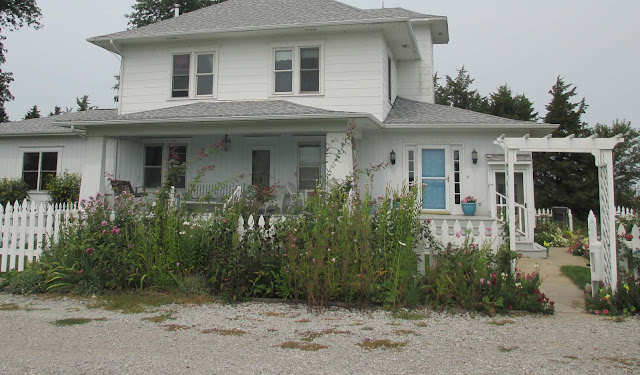I've been thinking for some time now that I need to totally redesign my North Border. This large border, 60 feet long by about 12 feet deep, has been beset by problems from the beginning:
- This is the border that I see from my kitchen window, and because it is a perennial, annual and bulb border, there is nothing for me to look at out there for about half the year.
- It's been hard to find enough tall perennials to fill the back third of the border, so that part has been taken over by weeds. In fact, it's not just the back third, the middle section is hard to reach and not tightly filled with perennials, so weeds reign.
- The left (west) end is in shade by noon from the large ash tree at the left side of the photo, so it's been hard to get anything to grow or flower in that area. Cue the weeds.
- The long rectangular strip shape of the North Border doesn't match very well with the newer curvy island shapes next to it. I would like to the bed shapes to relate to each other more cohesively.
So my plan is this:
- Reduce the length of the border, eliminating the shadiest 6-8 feet at left, to increase sunlight and flowering in the remaining border.
- Next spring, move the better performing herbaceous plants from the existing border into a new, smaller, curvy front area (perhaps to be called "The Summer Border").
- Plant only evergreen trees, shrubs and perennials in the existing border area (which could be called "The Winter Border"). Perhaps with a rock or statue or other permanent hardscape features for winter interest.
- Heavily mulch the entire back area (the current existing border) with wood chip mulch around the evergreen trees and shrubs, to inhibit the weed problem.
In winter and early spring, I would have the evergreen border and hardscape feature(s) to look at. I got the idea for doing an all-evergreen border from a photo I saw on Houzz.com:
 |
| This photo from Houzz.com provided me with some ideas for my own Winter Border. This border is called the Vermont All-Season Color Garden, and is a good idea for a place like Vermont that has especially long winters. (The warmer parts of Vermont are the same hardiness zone as here in southeast Iowa -- Zone 5B -- but the northern parts of the state are in Zone 3B, which can get as cold as -35F (-37C)!) Our growing season is longer than theirs, but winter still lasts too long in my opinion, and some bright colors and green foliage would be nice to see in the depths of winter. |
I'm not sure that I will plant quite so many trees and shrubs as are shown in the Vermont All-Season Color Garden (it appears to be a bit crowded, and I'm not sure what will happen when the trees grow in size). And in addition to conifers, I think I might try to include some evergreen plants that are not conifers in my Winter Border:
Those evergreen plants would give me something to look at in winter. In late spring, summer and autumn, the herbaceous plants and annuals in the front section (the Summer Border) would grow up in front of the evergreen border and provide the flowering that I crave to see out of my windows, and as that section is smaller than my current border, it would be easier to maintain and to contain enough plants to crowd out weeds (I think I will mulch the front section too this first year, while the plants establish themslves).
- shrubs like holly and rhododendrons
- perennials that often maintain their foliage over winters -- last January, I noticed that there were a number of perennials that kept their foliage in my gardens: dianthus, Iberis sempervirens, phlox subulata, Veronica spiccata, lamium, Polemonium, hellebore
Those evergreen plants would give me something to look at in winter. In late spring, summer and autumn, the herbaceous plants and annuals in the front section (the Summer Border) would grow up in front of the evergreen border and provide the flowering that I crave to see out of my windows, and as that section is smaller than my current border, it would be easier to maintain and to contain enough plants to crowd out weeds (I think I will mulch the front section too this first year, while the plants establish themslves).
I might leave the tulips, daffodils and other bulbs that are already planted in the back area between the evergreen trees and shrubs that I will plant next spring, so that I can enjoy them in spring, and the herbaceous foliage of the Summer Border will hide their withering foliage as it grows up. I might also plant some very early flowering bulbs there too, such as crocus, rock iris, early daffodils and maybe winter aconite. The idea is to have the back area have the green and other colors I want to see in winter, as well as the earliest signs of spring in late winter.
 |
| You can see the edge of the outlined area at right. I think the new curvy shape will fit in better with the curvaceous bed shapes of the North Island and Yellow Garden at left. |
 |
| While I was up the taking photos, I thought I might get one of the fields surrounding our house before the tall, golden corn is harvested. A quintessential Iowa scene. |
Anyway, my work will certainly be cut out for me next spring -- but it makes me happy to have something new to plan and think about over the coming winter.
Does anyone have any suggestions for colorful conifers that are readily available, and for non-conifer plants and shrubs that retain their foliage in Zone 5 winters?
Thanks for reading! -Beth





















